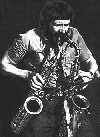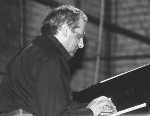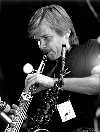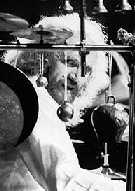 |
Vol 1, No 4, 19 July 1999
|
|
|
 J A Z Z:
J A Z Z:The Baltic Buzz: Jazz in Lithuania - past and present Bernd Jahnke Under Soviet domination, Lithuania was known to be the jazziest of all Soviet Republics, a leading status which it retained even after the breakup of the Union. Jazz and improvised music occupy a worthy position in the country's cultural spectrum and are perceived to be on an equal footing with other art forms, thus enabling them to achieve a rather broad level of public acceptance. Historical background While the presence of jazz during Lithuania's first period of independence (1918-1940) has been clearly documented, opinions differ very much on its extent and caliber. The city of Kaunas, the country's capital during that era, was clearly the center of such activities. In 1940, the first official jazz band was formed by the national radio broadcaster, but was forced to disband a year later after the country was invaded by waring Germany. By 1945, the Soviet Russian occupiers and Stalin's strict dictatorship prevented any resurgence of a jazz scene. It took over a decade for the first jazz orchestra to appear, that being the State Orchestra of the Lithuanian Soviet Republic. Placed under the direction of Juozas Tiskus, this outfit was staffed by well-trained musicians. Yet, it was hardly influential on the development of a national jazz scene, which could be related to the orchestra's constant schedule of tours beyond Lithiuanian borders. For many, the year 1961 marks the coming of age of a "modern" jazz scene in Lithuania. Back then, the country's National Conservatory - known today as the Lithuanian Academy of Music - organized a conference on issues in jazz theory and history. The high point of this event was a concert, and among its participants was a 17-year-old pianist by the name of Vyacheslav Ganelin - founder of the now legendary Ganelin trio. From that point on, the jazz scene flourished, especially in the capital of Vilnius. New activities were set in motion, musicianship was steadily improving and the musicians were becoming more self-assured in their abilities to improvise. By the mid-1960s, pianists Ganelin and Oleg Molokoyedov were fronting their own bands and shaping the course of jazz music nationally. Among their many appearances at that time, two particularly acclaimed ones took place during Estonia's Tallinn Jazz Festival in 1966 and 1967. The real breakthrough occurred in 1970-71, however, with the coming together of the Ganelin/Tarasov/Chekasin trio - the alleged instigators of the Vilnius Jazz School. The current state of jazz in Lithuania Today, jazz in Lithuania continues along the these traditions and - thanks largely to the special programs and opportunities which were provided under the Soviet Union - boasts a considerable number of well-trained musicians. Also worth noting is the fact that most of these players have a marked preference for contemporary and experimental strands of improvised music. Conversely, traditional and mainstream jazz is of peripheral interest, as is fusion or rock jazz for that matter. Another characteristic of the scene is the lack of long-lasting groups. Instead, the creation of numerous short-lived musical projects enables musicians to constantly develop their ideas, and thereby create an extremely effervescent national jazz scene. 
Leading figures The now legendary Ganelin trio came about more by chance than by design. Leaving his home of Arkhangelsk in Northern Russia, its percussionist, Vladimir Tarasov, settled in Vilnius in the late sixties. He soon met up with the pianist Vyacheslav Ganelin and began working with him in a duo setting. At a concert performed in the Siberian city of Sverdlovsk, the two met a local saxophonist, one Vladimir Chekasin. On the strengths of many shared interests, the reedman decided to move to Vilnius and the trio was born. The newly formed trio strove to develop their own means of musical expression, independent of Western European input or any of the predominant American trends. By 1987, after fifteen years, the group split up: the pianist emigrating to Israel, his associates deciding to pursue their own respective projects, albeit still collaborating on occasion in small and large ensembles. Tarsov then turned his attention to his self-titled ATTO solo percussion performances, while also composing music for both film and stage productions. Recently, he has set up a number of sound installations throughout Europe and the U.S. His American projects have been done in conjunction with artist and former compatriot Ilya Kabakov. Beyond that, he plays regularly with the Lithuanian Art Orchestra and two other multi-national ensembles - the Baltic Art Orchestra and Russian Art Orchestra. This latter group of some fifteen musicians enables Tarasov to devise his own pieces, combining improvised and compositional elements alike. Tarasov also plays with the Moscow Composers Orchestra and a host of other international projects. As founder of the Lithuanian Academy Big Band, Vladimir Chekasin is now greatly responsible for the training of the country's new musical talents. In fact, almost all musicians of note at the present time have gone through this schooling. An on-going part of his own work has been his long standing partnership with Oleg Molokoyedov, preferably working as a duo, though performing in variously configured quartets from time to time. He is equally involved on the international scene and develops his own large-scale projects, which frequently incorporate theatrical elements. Beyond that, he is also making a name for himself as a composer. Since emigrating to Israel a decade ago, pianist Vyacheslav Ganelin has devoted himself to solo or small group projects. Recently, he has been appearing more regularly in Lithuania, both in solo performances and as part of a trio with saxophonist Petras Vysniauskas and percussionist Arkady Gotesman, a native son now living in Israel as well. 
New generation The breakup of the Ganelin trio ushered in a new generation of musicians with ideas of their own. Both Vysniauskas and fellow reedman Vytas Labutis made their move toward center stage and attempted to give full expression to their musical aspirations. Beyond its free jazz inclinations, Lithuanian jazz music was now going through a new phase of development, one in which musicians were starting to incorporate elements of the Lithuanian folk tradition. The precedent for this trend was first set in the 1980s in a band comprised of Vysniauskas and Labutis on the front line, Leonid Shinkarenko on bass and Gediminas Laurinavicius on drums. Since then, other musicians have pursued this path: trombonist Skirmantas Sasnauskas and pianist and composer Tomas Kutavicius not only use folk melodies in their performances but native instruments as well. Also of note here is Vysniauskas's collaboration with vocalist Veronika Povilioniene, a singer possessed with a vast knowledge of her country's musical traditions and celebrated as the queen of its folk singers. Apart from his regular involvement in free music, Vysniauskas is a man of wide-ranging interests, a further indication of this being his occasional gigs with a string quartet. Another leading figure of the new Lithuanian jazz scene is saxophonist Vytas Labutis. Apart from his steady gigs with Chekasin and Tarasov, he also pursues his own interests. Minus Vysniauskas he played with his other two partners Shinkarenko and Laurinavicius as a trio, a unit which served as the basis for other groups, such as the Vilnius Quartet, with pianist Molokoyedov, or the quintet Gone with Jazz, with pianist Arturas Anusauskas and the highly touted singer-flutist Neda Malunaviciute, clearly a name to be reckoned with among the country's new generation of performers. In that same generation, saxophonist Liudas Mockunas and Danielius Praspaliauskis are sure up-and-comers, as are guitarist Juozas Milasius and the improvising percussionist Dalius Naujokaitis. An unconventional musician to say the least, Naujokaitis has been confounding and knocking local and foreign audiences off stride since the early part of this decade, most often in tandem with guitarist Milasius, but sometimes with Labutis, Kutavicius or Vysniauskas as added attractions. Other names worthy of mention within this contingent of newcomers are trombonist Vytas Pilibavicius, bassist Eugenijus Kanevicius and trumpeter Valerijus Ramoska, both of which are now making their mark on the development of the country's national jazz scene. Lithuania's presence on the World Stage The first breakthrough of Lithuanian jazz on to the world stage occurred in 1967 when the Ganelin trio took the Warsaw Jazz Jamboree by storm. Soon thereafter, invitations were pouring in from Eastern and Western Europe alike. A high point was the trio's extensive 17-city tour of North America in 1986. As pointed out previously, both Tarasov and Chekasin travel around Europe extensively in a variety of contexts, the former making regular visits to the States and even an occasional one to China. The Petras Vysniauskas quartet, for its part, landed on the international circuit in the mid-eighties thanks to a number of festival performances in Eastern and Northern Europe, thus opening the doors for its members to be part of groups active elsewhere in Europe. Vysniauskas for one was invited to play at Amsterdam's October Meeting of 1991, where he encounter such leading figures of European improvised music as cellist Tristan Honsinger, saxmen Evan Parker and Steve Lacy and drummer Han Bennink. Since then, he has been working steadily with players in Germany, Switzerland and France. Throughout the present decade, both Vysniauskas and Labutis have been constantly involved in several international groups, one of these being the Jazz Baltica Ensemble, an orchestra of varying personnel which performs every year at the Salzau festival in Northern Germany. In 1995, both saxmen were chosen to represent Lithuania at a festival in Perth, Australia, performing with vocalist Povilioniene and Dalius Naujokaitis. These musicians could also be heard in North America during the Ford Montreux Detroit Festival and in a concert sponsored by the New York Anthology Film Archives. Of the previously named musicians, Naujokaitis has been living in New York for the past three years. When not leading his own Second Street Free Jazz Ensemble, he has been involved with the Anthology Film Archives, working with Jonas Mekas, an experimental filmmaker of Lithuanian origin. 
The national concert and festival circuit Performances of foreign musicians are more of the exception than the rule, these being limited to large festivals. The most significant of these is Vilnius Jazz, a yearly event first established in October 1988. Throughout the decade of its existence, it has acquired a unique profile for its ability to attract musicians from all over Europe, Asia and even the United States, with a special spot granted to its home-grown talent. The basic motivation of this event is to bring musically productive artistic endeavors to the attention of the public. In this sense, it measures up to similar festivals in Mulhouse, France; Nickelsdorf; Austria ; Varna, Bulgaria ; or Victoriaville, Canada and has developed into an important meeting point for Eastern and Western cultural ventures. Founded in 1991 by Jonas Jucas, the Kaunas Jazz Festival is a yearly event held in April. While its musical standards are of a high caliber, the more experimental facets embraced by the national scene are downplayed in its programming. As such, it is more geared towards a broader audience, having attracted headliners like John Scofield, Charles Lloyd, Elvin Jones or Jan Garbarek in the past. With its own emphasis on the mainstream, this festival serves as a nice compliment to the one in Vilnius. The oldest festival in the country is a biannual event which takes place in the city of Birstonas. Founded in 1980, it is solely focused on national talent, with special emphasis given to younger musicians. Also worth mentioning is the Sing Jazz Festival, held every November in the town of Panevezys, an event which, accordingly, is exclusively devoted to jazz vocalists. As for a club scene, it is currently in a state of expansion, with Vilnius and Kaunas leading the way, but more and more venues to be found in coastal cities such as Klaipeda and Palanga. In Vilnius, for instance, the Music Club Langas in the old quarter has become the musical hotbed for the improvised music scene, providing a venue for the presentation of new projects once or twice a week. Beyond that, there are numerous restaurants, bars and cafes that offer live jazz, not to mention many concert halls and theaters which open their doors to jazz music as well. Final thoughts This overview of the Lithuanian jazz scene does not pretend to be exhaustive, of course, but merely highlights some its most representative facets. Recordings and media input have been overlooked here (see the accompanying list of Lithuanian jazz CDs), while the problems concerning the training of new talent have been glossed over. All of these considerations are important in order to better understand the broader picture, but they can only be appreciated in a more extensive overview of the subject matter at hand. This article appears courtesy of the Jazz Institute of Chicago.
For further information on the Vilnius Jazz festival contact: See CER's comprehensive list of Lithuanian jazz recordings
|
|
![]()
Copyright (c) 1999 - Central Europe Review Internet servis, a.s.
All Rights Reserved